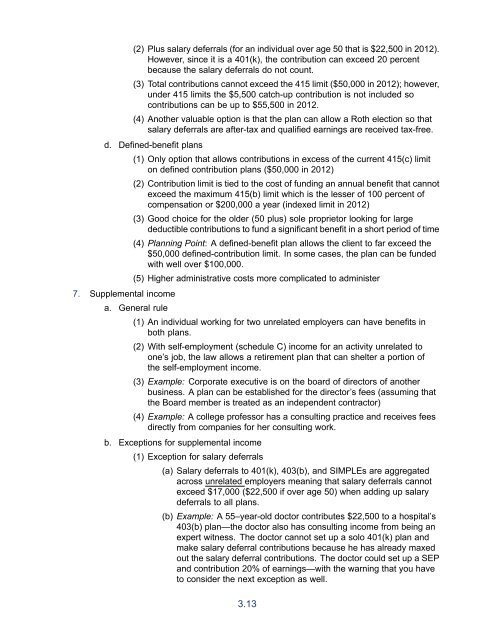section 1 - The American College Online Learning Center
section 1 - The American College Online Learning Center
section 1 - The American College Online Learning Center
You also want an ePaper? Increase the reach of your titles
YUMPU automatically turns print PDFs into web optimized ePapers that Google loves.
(2) Plus salary deferrals (for an individual over age 50 that is $22,500 in 2012).However, since it is a 401(k), the contribution can exceed 20 percentbecause the salary deferrals do not count.(3) Total contributions cannot exceed the 415 limit ($50,000 in 2012); however,under 415 limits the $5,500 catch-up contribution is not included socontributions can be up to $55,500 in 2012.(4) Another valuable option is that the plan can allow a Roth election so thatsalary deferrals are after-tax and qualified earnings are received tax-free.d. Defined-benefit plans7. Supplemental income(1) Only option that allows contributions in excess of the current 415(c) limiton defined contribution plans ($50,000 in 2012)(2) Contribution limit is tied to the cost of funding an annual benefit that cannotexceed the maximum 415(b) limit which is the lesser of 100 percent ofcompensation or $200,000 a year (indexed limit in 2012)(3) Good choice for the older (50 plus) sole proprietor looking for largedeductible contributions to fund a significant benefit in a short period of time(4) Planning Point: A defined-benefit plan allows the client to far exceed the$50,000 defined-contribution limit. In some cases, the plan can be fundedwith well over $100,000.(5) Higher administrative costs more complicated to administera. General rule(1) An individual working for two unrelated employers can have benefits inboth plans.(2) With self-employment (schedule C) income for an activity unrelated toone’s job, the law allows a retirement plan that can shelter a portion ofthe self-employment income.(3) Example: Corporate executive is on the board of directors of anotherbusiness. A plan can be established for the director’s fees (assuming thatthe Board member is treated as an independent contractor)(4) Example: A college professor has a consulting practice and receives feesdirectly from companies for her consulting work.b. Exceptions for supplemental income(1) Exception for salary deferrals(a) Salary deferrals to 401(k), 403(b), and SIMPLEs are aggregatedacross unrelated employers meaning that salary deferrals cannotexceed $17,000 ($22,500 if over age 50) when adding up salarydeferrals to all plans.(b) Example: A 55–year-old doctor contributes $22,500 to a hospital’s403(b) plan—the doctor also has consulting income from being anexpert witness. <strong>The</strong> doctor cannot set up a solo 401(k) plan andmake salary deferral contributions because he has already maxedout the salary deferral contributions. <strong>The</strong> doctor could set up a SEPand contribution 20% of earnings—with the warning that you haveto consider the next exception as well.3.13
















